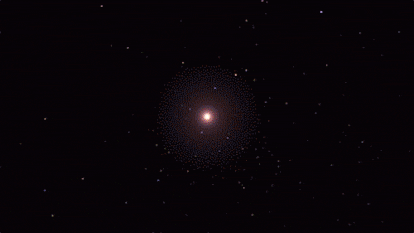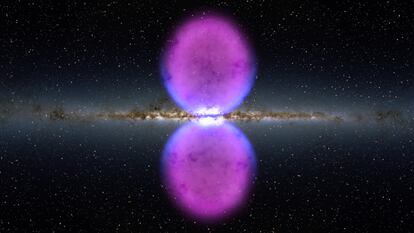The astrophysicists who want to reveal the greatest mystery of our galaxy
A huge bubble in the center of the Milky Way of unknown origin has captured the attention of the ‘Fermi’ space telescope scientists

A month before being shot dead in his official car, in October 1963, U.S. president John F. Kennedy approved the launch of satellites to warn of the greatest disaster imaginable: the explosion of an atomic bomb. In 1967, this surveillance program called Vela detected mysterious bursts that did not come from Earth, but from outer space. The matter was kept in a drawer until, years later, it was learned that those signals were the most powerful type of radiation in the universe, possibly arriving from outside our galaxy. A new way of observing the universe had been accidentally discovered: gamma-ray astronomy.
Invisible to the human eye, gamma rays are ubiquitous and allow us to study the most violent phenomena in the cosmos. “In a brief instant, gamma ray bursts release more energy than all the stars in the universe combined,” explains Peter Michelson, an astrophysicist at Stanford University and the brain behind the Fermi gamma-ray space telescope. Fermi was launched in 2008 by NASA to continue the surveillance work started by Cold War satellites in a more scientific way. In a matter of hours, the Fermi team of more than 400 scientists from 17 countries can detect a new source of gamma rays, locate its origin and alert other space and ground telescopes to observe it. The researchers in charge of the main scientific instrument on board the Fermi met for the first time in Spain to discuss their new objectives, such as understanding a third of all signals, which are of unknown origin.

Short bursts of gamma rays last fractions of a second. They happen just as two neutron stars — which are so dense and compact that a single teaspoon weighs a billion tons — collide. Long bursts, lasting a few minutes at most, occur when a star about 30 times larger than the sun reaches the end of its life and explodes, creating a supernova. The outer layers are blown off as the core collapses in on itself. The force of gravity is so strong that it forms a point of infinite density: a black hole. “If the black hole also rotates on itself, which almost always happens, it produces a burst of gamma rays as powerful as what an entire galaxy produces,” says Michelson. No atomic bomb would be even remotely capable of producing a similar amount of energy.
Irish astrophysicist Deirdre Horan, a member of the Fermi science team, explains: “Gamma rays are also one of the types of radiation that fluctuates the fastest and most dramatically; to the point that some sources turn the sky into a disco.” “It’s fascinating how nature can create something like this,” she adds. The researcher is referring to pulsars, rotating neutron stars that emit periodic flashes with such accuracy that they can be used as chronometers to measure — with very high precision — other phenomena, such as the radiation produced by the Big Bang, 13.7 billion years ago.
The Fermi operates 24 hours a day, every day of the week. From its orbit, more than 310 miles from the Earth’s surface, it can cover the entire sky every three hours. Since its launch, it has identified more than 7,000 sources of gamma rays from inside and outside the Milky Way. Its findings show that Earth is a tiny dot in space literally surrounded by gamma-ray sources, many of them pulsars of exquisite punctuality. Some signals come from dizzying distances, such as gamma light that was emitted 12.5 billion years ago, when the universe was almost a newborn. Due to the accelerated expansion of the cosmos, this object is already 25 billion light years away, meaning that to reach it you would have to travel at the speed of light for almost twice the total age of the universe.
Charged atomic particles constantly bombard Fermi’s equipment. Although in theory, the space telescope was built to last only five years, its inventors and builders made sure to give it large solar panels that continue to function despite losing efficiency due to the constant radioactive bombardment. On at least one occasion, the telescope has had to skirt around pieces of space debris that could have knocked it out forever. The scientific team, which is meeting until Friday at the Institute of Theoretical Physics in Madrid, estimates that Fermi could last for another decade. It is crucial that it continues to work: without it, humanity would be blind to this type of gamma rays; there is no successor in sight.

Spanish astrophysicist Miguel Ángel Sánchez Conde will be the new scientific coordinator of the Fermi-LAT collaboration. One of its main objectives is to use the telescope to try to identify dark matter. “It would be a discovery that would take us directly to Stockholm to collect the Nobel Prize,” he says.
Dark matter makes up 25% of the entire universe, but no one has been able to observe it or determine what it is made of. “Many of the unidentified sources could be small halos of dark matter that are annihilating, and in doing so emit gamma rays,” says Sánchez. This possibility could fit with some current proposals to explain dark matter, such as weakly interacting massive particles (WIMPS).
One of the “biggest mysteries” facing the team is right in the center of our galaxy, explains Sánchez. In this place there is a black hole — Sagittarius A* — with a mass four million times greater than the sun. “Since 2010, we have been capturing a constant signal from the galactic center. But in the other galaxies that have supermassive black holes in the center, we do not see anything similar. It’s an excess of gamma rays that we simply cannot understand. No one knows why this is happening, but new studies are published almost every day on this problem. There are already thousands of studies on this mystery,” says the researcher.
In 2010, Fermi discovered a gigantic bubble-like structure located just above and below the center of our galaxy. The two lobes are so enormous that it would take 50,000 years to cross them from end to end, traveling at the speed of light. Fourteen years later, these Fermi bubbles remain one of the greatest mysteries of our cosmic environment.
It is possible that they are the remains of Sagittarius A*’s last feast when it swallowed a gas cloud about six million years ago. Or the enigma may be related to the constant gamma ray signal being emitted from the galactic center and which, in turn, could be due to the annihilation of dark matter, argues Sánchez.
For Horan, another great moment will come in approximately a month, when three large terrestrial gravitational wave detectors — LIGO, Virgo and Kagra, in the U.S., Europe and Japan, respectively — begin to operate. “They’re going to send out alerts as soon as they detect a gravitational wave, but normally you don’t know where it’s coming from. Fermi has a huge field of view and can help a lot. It’s very exciting to see if we can pick up electromagnetic signals as a counterpart to gravitational waves. Theory tells us that two colliding black holes should not emit gamma rays. But if they are two neutron stars, we could see them. This happened in 2017, and it was like, ‘Oh my God, we caught one!’ We will probably see many more now,” she says.
For Michelson, all possibilities are open. “I think there are things out there that we haven’t even imagined; and theorists have a lot of imagination.”
Sign up for our weekly newsletter to get more English-language news coverage from EL PAÍS USA Edition
Tu suscripción se está usando en otro dispositivo
¿Quieres añadir otro usuario a tu suscripción?
Si continúas leyendo en este dispositivo, no se podrá leer en el otro.
FlechaTu suscripción se está usando en otro dispositivo y solo puedes acceder a EL PAÍS desde un dispositivo a la vez.
Si quieres compartir tu cuenta, cambia tu suscripción a la modalidad Premium, así podrás añadir otro usuario. Cada uno accederá con su propia cuenta de email, lo que os permitirá personalizar vuestra experiencia en EL PAÍS.
¿Tienes una suscripción de empresa? Accede aquí para contratar más cuentas.
En el caso de no saber quién está usando tu cuenta, te recomendamos cambiar tu contraseña aquí.
Si decides continuar compartiendo tu cuenta, este mensaje se mostrará en tu dispositivo y en el de la otra persona que está usando tu cuenta de forma indefinida, afectando a tu experiencia de lectura. Puedes consultar aquí los términos y condiciones de la suscripción digital.
More information
Archived In
Últimas noticias
Most viewed
- Oona Chaplin: ‘I told James Cameron that I was living in a treehouse and starting a permaculture project with a friend’
- Reinhard Genzel, Nobel laureate in physics: ‘One-minute videos will never give you the truth’
- Sinaloa Cartel war is taking its toll on Los Chapitos
- Why the price of coffee has skyrocketed: from Brazilian plantations to specialty coffee houses
- Silver prices are going crazy: This is what’s fueling the rally










































